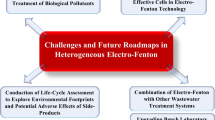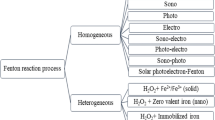Abstract
Triggered by global water quality safety issues, the research on wastewater treatment and water purification technology has been greatly developed in recent years. The Fenton technology is particularly powerful due to the rapid attack on pollutants by the generated hydroxyl radicals (•OH). However, both heterogeneous and homogeneous Fenton/Fenton-like technologies follow the classical reaction mechanism, which depends on the oxidation and reduction of the transition metal ions at single sites. So even after a century of development, this reaction still suffers from its inherent bottlenecks in practical application. In recent years, our group has been focusing on studying a novel heterogeneous Fenton catalytic process, and we developed the dual-reaction-center (DRC) system for the first time. In the DRC system, H2O2 and O2 can be efficiently reduced to reactive oxygen species (ROS) in electron-rich centers, while pollutants are captured and oxidized by the electron-deficient centers. The obtained electrons from pollutants are diverted to the electron-rich centers through bonding bridges. This process breaks through the classic Fenton mechanism, and improves the performance and efficiency of pollutant removal in a wide pH range. Here, we provide a brief overview of Fenton’s story and focus on combing the discovery and development of the DRC technology and mechanism in recent years. The construction of the DRC and its performance in the pollutant degradation and interfacial reaction process are described in detail.We look forward to bringing a new perspective to continue Fenton’s story through research and development of DRC technology.

Similar content being viewed by others
References
Bui V K H, Pham T N, Lee Y C (2019). One-pot synthesis of magnesium aminoclay-iron oxide nanocomposites for improved photo-Fenton catalytic performance. Journal of Nanoscience and Nanotechnology, 19(2): 1069–1073
Cao W R, Han M E, Lyu L, Hu C, Xiao F (2019). Efficient Fenton-like process induced by fortified electron-rich O microcenter on the reduction state Cu-doped CNO polymer. ACS Applied Materials & Interfaces, 11(18): 16496–16505
Cao W R, Lyu L, Deng K L, Lu C, Hu C (2020). ι-ascorbic acid oxygeninduced micro-electronic fields over metal-free polyimide for peroxymonosulfate activation to realize efficient multi-pathway destruction of contaminants. Journal of Materials Chemistry. A, 8 (2): 810–819
Eisenhauer H R (1964). Oxidation of phenolic wastes. Journal-Water Pollution Control Federation, 36(9): 1116–1128
Fenton H J H (1876). On a new reaction of tartaric acid. Chemistry News, 33: 190–195
Fenton H J H (1894). LXXIII.—Oxidation of tartaric acid in presence of iron. Journal of the Chemical Society Transactions, 65: 899–910
Fenton H J H (1896). XLI.—The constitution of a new dibasic acid, resulting from the oxidation of tartaric acid. Journal of the Chemical Society Transactions, 69: 546–562
Fenton H J H, Jones H O (1900). VII.—The oxidation of organic acids in presence of ferrous iron. Part I. Journal of the Chemical Society Transactions, 77: 69–76
Gao Y W, Li T, Zhu Y, Chen Z H, Liang J Y, Zeng Q Y, Lyu L, Hu C (2019). Highly nitrogen-doped porous carbon transformed from graphitic carbon nitride for efficient metal-free catalysis. Journal of Hazardous Materials, 393: 121280
Gao Y W, Zhu Y, Lyu L, Zeng Q Y, Xing X C, Hu C (2018). Electronic structure modulation of graphitic carbon nitride by oxygen doping for enhanced catalytic degradation of organic pollutants through peroxymonosulfate activation. Environmental Science & Technology, 52(24): 14371–14380
Haber F, Weiss J (1932). Über die katalyse des hydroperoxydes. Naturwissenschaften, 20(51): 948–950
Han M E, Lyu L, Huang Y M, Liang J R, Xue M M, Wu T, Li J Y, Chen M P, Hu C (2019). In situ generation and efficient activation of H2O2 for pollutant degradation over CoMoS2 nanosphere-embedded rGO nanosheets and its interfacial reaction mechanism. Journal of Colloid and Interface Science, 543: 214–224
Huang L Z, Zhu M T, Liu Z Z, Wang Z P, Hansen H C B (2019). Single sheet iron oxide: An efficient heterogeneous electro-Fenton catalyst at neutral pH. Journal of Hazardous Materials, 364: 39–47
Lagutschenkov A, Sinha R K, Maitre P, Dopfer O (2010). Structure and infrared spectrum of the Ag+-Phenol ionic complex. Journal of Physical Chemistry A, 114(42): 11053–11059
Lu Y B, He S L, Yu G F, Wang D T, Luo S Y, Liu A P, Luo H P, Liu G L, Zhang R D (2018). A pulsed switching peroxi-coagulation process to control hydroxyl radical production and to enhance 2,4-Dichlorophenoxyacetic acid degradation. Frontiers of Environmental Science & Engineering, 12(5): 9
Lyu L, Cao W R, Yu G F, Yan D B, Deng K L, Lu C, Hu C (2020). Enhanced polarization of electron-poor/rich micro-centers over nZVCu-Cu(II)-rGO for pollutant removal with H2O2. Journal of Hazardous Materials, 383: 121182
Lyu L, Han M E, Cao W R, Gao Y W, Zeng Q Y, Yu G F, Huang X, Hu C (2019). Efficient Fenton-like process for organic pollutant degradation on Cu-doped mesoporous polyimide nanocomposites. Environmental Science. Nano, 6(3): 798–808
Lyu L, Yan D B, Yu G F, Cao W R, Hu C (2018a). Efficient destruction of pollutants in water by a dual-reaction center Fenton-like process over carbon nitride compounds-complexed Cu(II)-CuAlO2. Environmental Science & Technology, 52(7): 4294–4304
Lyu L, Yu G F, Zhang L L, Hu C, Sun Y (2018b). 4-phenoxyphenolfunctionalized reduced graphene oxide nanosheets: A metal-free Fenton-like catalyst for pollutant destruction. Environmental Science & Technology, 52(2): 747–756
Lyu L, Zhang L L, He G Z, He H, Hu C (2017). Selective H2O2 conversion to hydroxyl radicals in the electron-rich area of hydroxylated C-g-C3N4/CuCo-Al2O3. Journal of Materials Chemistry. A, 5(15): 7153–7164
Lyu L, Zhang L L, Hu C (2015a). Enhanced Fenton-like degradation of pharmaceuticals over framework copper species in copper-doped mesoporous silica microspheres. Chemical Engineering Journal, 274: 298–306
Lyu L, Zhang L L, Hu C (2016a). Galvanic-like cells produced by negative charge nonuniformity of lattice oxygen on d-TiCuAl-SiO2 nanospheres for enhancement of Fenton-catalytic efficiency. Environmental Science. Nano, 3(6): 1483–1492
Lyu L, Zhang L L, Hu C, Yang M (2016b). Enhanced Fenton-catalytic efficiency by highly accessible active sites on dandelion-like copperaluminum-silica nanospheres for water purification. Journal of Materials Chemistry. A, 4(22): 8610–8619
Lyu L, Zhang L L,Wang Q Y, Nie Y L, Hu C (2015b). Enhanced Fenton catalytic efficiency of gamma-Cu-Al2O3 by sigma-Cu2+-Ligand complexes from aromatic pollutant degradation. Environmental Science & Technology, 49(14): 8639–8647
Navalon S, De Miguel M, Martin R, Alvaro M, Garcia H (2011). Enhancement of the catalytic activity of supported gold nanoparticles for the Fenton reaction by light. Journal of the American Chemical Society, 133(7): 2218–2226
Ou X X, He S L, Yan J F, Zhang F J, Zhang C H (2018). Accelerated degradation of orange G over a wide pH range in the presence of FeVO4. Frontiers of Environmental Science & Engineering, 12(1): 7
Saleh R, Taufik A (2019). Degradation of methylene blue and congo-red dyes using Fenton, photo-Fenton, sono-Fenton, and sonophoto-Fenton methods in the presence of iron (II,III) oxide/zinc oxide/ graphene (Fe3O4/ZnO/graphene) composites. Separation and Purification Technology, 210: 563–573
Shi J G, Ai Z H, Zhang L Z (2014). Fe@Fe2O3 core-shell nanowires enhanced Fenton oxidation by accelerating the Fe(III)/Fe(II) cycles. Water Research, 59: 145–153
Tušar N N, Maucec D, Rangus M, Arcon I, Mazaj M, Cotman M, Pintar A, Kaucic V (2012). Manganese functionalized silicate nanoparticles as a Fenton-type catalyst for water purification by advanced oxidation processes (AOP). Advanced Functional Materials, 22(4): 820–826
Wang L, Huang X, Han M E, Lyu L, Li T, Gao Y W, Zeng Q Y, Hu C (2019). Efficient inhibition of photogenerated electron-hole recombination through persulfate activation and dual-pathway degradation of micropollutants over iron molybdate. Applied Catalysis B: Environmental, 257: 117904
Wang L, Yan D B A, Lyu L, Hu C, Jiang N, Zhang L L (2018). Notable light-free catalytic activity for pollutant destruction over flower-like BiOI microspheres by a dual-reaction-center Fenton-like process. Journal of Colloid and Interface Science, 527: 251–259
Xie Z Q, Zhou J L, Wang J N, Francois-Xavier C P, Wintgens T (2019). Novel Fenton-like catalyst gamma-Cu-Al2O3-Bi12O15Cl6 with electron-poor Cu centre and electron-rich Bi centre for enhancement of phenolic compounds degradation and H2O2 utilization: The synergistic effects of sigma-Cu-ligand, dual-reaction centres and oxygen vacancies. Applied Catalysis B: Environmental, 253: 28–40
Xu S Q, Zhu H X, Cao W R, Wen Z B, Wang J N, Francois-Xavier C P, Wintgens T (2018). Cu-Al2O3-g-C3N4 and Cu-Al2O3-C-dots with dual-reaction centres for simultaneous enhancement of Fenton-like catalytic activity and selective H2O2 conversion to hydroxyl radicals. Applied Catalysis B: Environmental, 234: 223–233
Yoo S H, Jang D, Joh H I, Lee S (2017). Iron oxide/porous carbon as a heterogeneous Fenton catalyst for fast decomposition of hydrogen peroxide and efficient removal of methylene blue. Journal of Materials Chemistry. A, 5(2): 748–755
Zhang L L, Lyu L, Nie Y L, Hu C (2016). Cu-doped Bi2O3/Bi-0 composite as an efficient Fenton-like catalyst for degradation of 2-chlorophenol. Separation and Purification Technology, 157: 203–208
Zhang L L, Nie Y L, Hu C, Qu J H (2012). Enhanced Fenton degradation of rhodamine B over nanoscaled Cu-doped LaTiO3 perovskite. Applied Catalysis B: Environmental, 125: 418–424
Zhang L L, Xu D A, Hu C, Shi Y L (2017). Framework Cu-doped A1PO4 as an effective Fenton-like catalyst for bisphenol A degradation. Applied Catalysis B: Environmental, 207: 9–16
Zhuang Y, Liu Q Z, Kong Y, Shen C C, Hao H T, Dionysiou D D, Shi B Y (2019a). Enhanced antibiotic removal through a dual-reactioncenter Fenton-like process in 3D graphene based hydrogels. Environmental Science. Nano, 6(2): 388–398
Zhuang Y,Wang X C, Zhang L L, Dionysiou D D, Shi B Y (2019b). Fe-Chelated polymer templated graphene aerogel with enhanced Fentonlike efficiency for water treatment. Environmental Science. Nano, 6 (11): 3232–3241
Acknowledgements
The related work was financially supported by the Guangdong Province Universities and Colleges Pearl River Scholar Funded Scheme (Young Scholar), the Introduced Innovative R&D Team Project under the “Pearl River Talent Recruitment Program” of Guangdong Province (No. 2019ZT08L387), the Natural Science Foundation of Guangdong Province (No. 2018A030313487), the National Natural Science Foundation of China (Grant Nos. 51808140, 51838005 and 51538013) and the Young Innovative Talent Project in Higher Education of Guangdong Province (No. 2017KQNCX150).
Author information
Authors and Affiliations
Corresponding author
Additional information
Highlights
• Dual-reaction-center (DRC) system breaks through bottleneck of Fenton reaction.
• Utilization of intrinsic electrons of pollutants is realized in DRC system.
• DRC catalytic process well continues Fenton’s story.
Chao Lu received his bachelor’s degree from Nanjing University of Aeronautics and Astronautics, China in 2018 and is now a graduate student in Environmental Engineering at Guangzhou University, China under the supervision of Dr. Lai Lyu. He is mainly engaged in the construction of surface DRCs for Fenton-like water treatment technology.
Kanglan Deng received her bachelor’s degree in 2018 and is now a graduate student majoring in Environmental Science at Guangzhou University, China under the supervision of Dr. Lai Lyu. Her research focus is on the mechanism exploration of metal-organic DRC Fenton catalysis.
Chun Hu received her Ph.D. degree from RCEES, CAS in 2001 and was funded by National Natural Science Funds for Distinguished Young Scholar of China in 2011. She is now the dean and chief scientist of the IERGBA, Guangzhou University, China. She mainly focuses on the research of environmental chemistry and interface chemistry.
Lai Lyu received his Ph.D. degree from University of Chinese Academy of Sciences in 2017 and was awarded as “Young Pearl River Scholar” in 2019. He is now an associate professor at the IERGBA, Guangzhou University, China. He focuses on the research of interface chemistry and heterogeneous catalysis for water treatment.
Rights and permissions
About this article
Cite this article
Lu, C., Deng, K., Hu, C. et al. Dual-reaction-center catalytic process continues Fenton’s story. Front. Environ. Sci. Eng. 14, 82 (2020). https://doi.org/10.1007/s11783-020-1261-x
Received:
Revised:
Accepted:
Published:
DOI: https://doi.org/10.1007/s11783-020-1261-x




